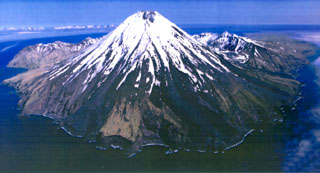Report on Kanaga (United States) — 20 December-26 December 2023
Smithsonian Institution / US Geological Survey
Weekly Volcanic Activity Report, 20 December-26 December 2023
Managing Editor: Sally Sennert.
Please cite this report as:
Global Volcanism Program, 2023. Report on Kanaga (United States) (Sennert, S, ed.). Weekly Volcanic Activity Report, 20 December-26 December 2023. Smithsonian Institution and US Geological Survey.
Kanaga
United States
51.923°N, 177.168°W; summit elev. 1307 m
All times are local (unless otherwise noted)
AVO reported that the rate of seismicity at Kanaga significantly declined after the explosion on 18 December and was slightly elevated with small daily earthquakes during 19-26 December. Satellite observations following the event showed a debris flow extending 1.5 km down the NW flank. Possible minor steaming was visible in a webcam image on 20 December. Weakly elevated surface temperatures were identified in satellite data during 23-26 December. The Volcano Alert Level remained at Advisory (the second level on a four-level scale) and the Aviation Color Code remained at Yellow (the second color on a four-color scale).
Geological Summary. Symmetrical Kanaga stratovolcano is situated within the Kanaton caldera at the northern tip of Kanaga Island. The caldera rim forms a 760-m-high arcuate ridge south and east of Kanaga; a lake occupies part of the SE caldera floor. The volume of subaerial dacitic tuff is smaller than would typically be associated with caldera collapse, and deposits of a massive submarine debris avalanche associated with edifice collapse extend nearly 30 km to the NNW. Several fresh lava flows from historical or late prehistorical time descend the flanks of Kanaga, in some cases to the sea. Historical eruptions, most of which are poorly documented, have been recorded since 1763. Kanaga is also noted petrologically for ultramafic inclusions within an outcrop of alkaline basalt SW of the volcano. Fumarolic activity occurs in a circular, 200-m-wide, 60-m-deep summit crater and produces vapor plumes sometimes seen on clear days from Adak, 50 km to the east.
Source: US Geological Survey Alaska Volcano Observatory (AVO)

